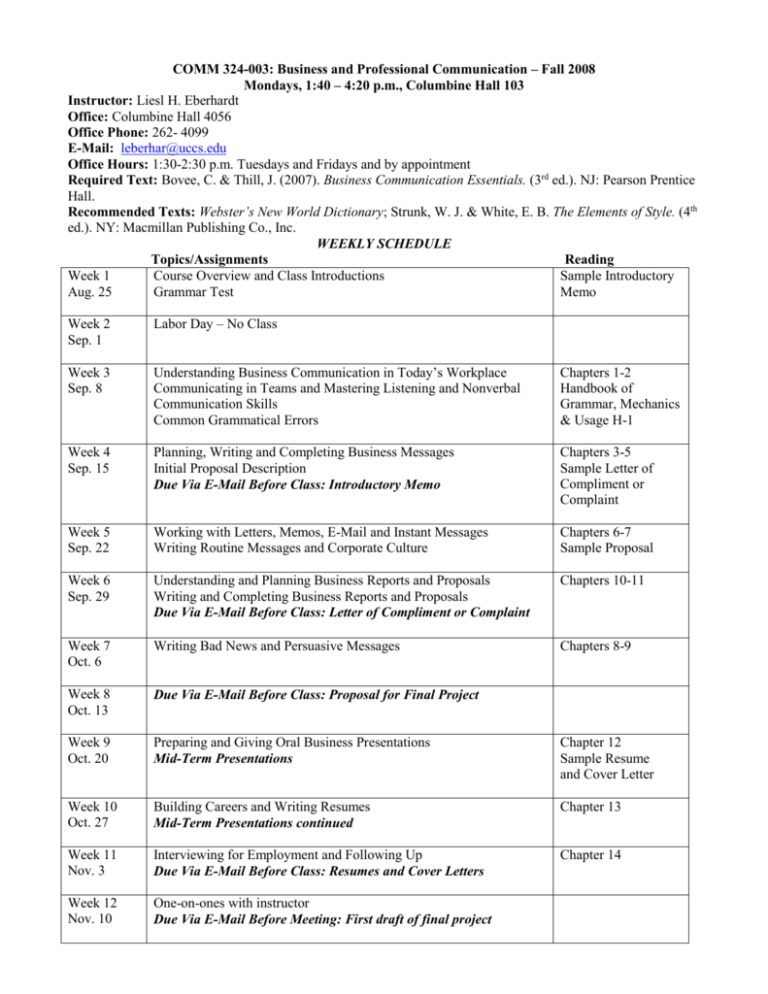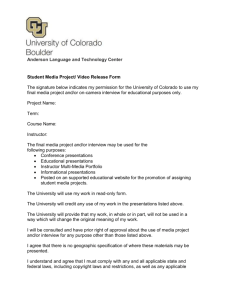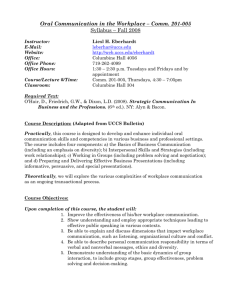
COMM 324-003: Business and Professional Communication – Fall 2008
Mondays, 1:40 – 4:20 p.m., Columbine Hall 103
Instructor: Liesl H. Eberhardt
Office: Columbine Hall 4056
Office Phone: 262- 4099
E-Mail: leberhar@uccs.edu
Office Hours: 1:30-2:30 p.m. Tuesdays and Fridays and by appointment
Required Text: Bovee, C. & Thill, J. (2007). Business Communication Essentials. (3rd ed.). NJ: Pearson Prentice
Hall.
Recommended Texts: Webster’s New World Dictionary; Strunk, W. J. & White, E. B. The Elements of Style. (4th
ed.). NY: Macmillan Publishing Co., Inc.
WEEKLY SCHEDULE
Topics/Assignments
Reading
Week 1
Course Overview and Class Introductions
Sample Introductory
Aug. 25
Grammar Test
Memo
Week 2
Sep. 1
Labor Day – No Class
Week 3
Sep. 8
Understanding Business Communication in Today’s Workplace
Communicating in Teams and Mastering Listening and Nonverbal
Communication Skills
Common Grammatical Errors
Chapters 1-2
Handbook of
Grammar, Mechanics
& Usage H-1
Week 4
Sep. 15
Planning, Writing and Completing Business Messages
Initial Proposal Description
Due Via E-Mail Before Class: Introductory Memo
Chapters 3-5
Sample Letter of
Compliment or
Complaint
Week 5
Sep. 22
Working with Letters, Memos, E-Mail and Instant Messages
Writing Routine Messages and Corporate Culture
Chapters 6-7
Sample Proposal
Week 6
Sep. 29
Understanding and Planning Business Reports and Proposals
Writing and Completing Business Reports and Proposals
Due Via E-Mail Before Class: Letter of Compliment or Complaint
Chapters 10-11
Week 7
Oct. 6
Writing Bad News and Persuasive Messages
Chapters 8-9
Week 8
Oct. 13
Due Via E-Mail Before Class: Proposal for Final Project
Week 9
Oct. 20
Preparing and Giving Oral Business Presentations
Mid-Term Presentations
Chapter 12
Sample Resume
and Cover Letter
Week 10
Oct. 27
Building Careers and Writing Resumes
Mid-Term Presentations continued
Chapter 13
Week 11
Nov. 3
Interviewing for Employment and Following Up
Due Via E-Mail Before Class: Resumes and Cover Letters
Chapter 14
Week 12
Nov. 10
One-on-ones with instructor
Due Via E-Mail Before Meeting: First draft of final project
Week 13
Nov. 17
Week 14
Nov. 24
One-on-ones with instructor continue / Peer reviews
Due Via E-Mail Before Meeting: Draft of final project for peer
review
Exam
Week 15
Dec. 1
Final Presentations
All Final Projects Due Via E-Mail the First Week of Presentations
Week 16
Dec. 8
Final Presentations continued
Week 17
Dec. 15
Final Presentations continued
WRITING ASSIGNMENTS
Introductory memo: This memo should be at least 1½ pages long introducing yourself to the instructor. You
should touch on the following topics: background, interests, achievements, goals, reasons for taking this class.
Use a proper memo format with a conversational writing style.
Letter of compliment or complaint: Compose a letter based on an actual experience (retail, service or
workplace) in which you offer a compliment or a complaint. Your letter should be accurately addressed and
include appropriate details on the experience. (Students who receive a response and bring a copy of that response
to share with the class will receive 5 points extra credit.)
Preliminary proposal for final project: This is a preliminary proposal to get approval to conduct the research
and write the final project. Examples will be provided during class.
Resume and cover letter: Students will be required to find a recent job posting and complete a resume and cover
letter based on that job description. This should be a position for which you are qualified.
Final project: Each class member will prepare a written business proposal (page count to be determined by topic,
but it should be about 12-15 pages) and a business presentation (9-12 minutes) for a real issue in a real business
organization (e.g., your current job or the university). Details of the assignment will be given in class. A first draft
will be turned in during a one-on-one meeting with the instructor during which time the draft will be read/edited.
Students are also required to have another read of the paper, either during the peer-edit class time or by taking a
copy to The Writing Center (Columbine 316) – proof of your choice will be required.
SPEAKING ASSIGNMENTS
Mid-Term presentation: Students will give a 4-6 minute presentation on a trend that is impacting or will impact
your chosen career field. Students unsure of career fields can identify an issue or trend affecting business
communication. Other topics can be chosen with instructor’s approval. Presentations will be recorded; in order to
receive full credit for the presentation, students must view their presentation at the Center for Excellence in Oral
Communication (Columbine 312) within two weeks of the presentation. Students must purchase and bring a mini
DVC (digital video cassette) that works with a Sony Handicam to class on the day they present. These are very
inexpensive and vary from $2-5 in various recording minutes and are available in many stores and at the
bookstore. I will show you an example in class well in advance. Students will submit a self-evaluation after
viewing the speech in the lab.
Final presentation: An oral presentation of your final project, 9-12 minutes in duration. Those exceeding 13
minutes 30 seconds will be stopped. For the presentation, oral competency is required. Extensive reading of notes
is unacceptable both in the business world and in this class. Visual aids are required.
EXAM
In-class writing assignment, putting to use all the concepts learned from lecture and reading.
PARTICIPATION AND ATTENDANCE
You must attend regularly and participate actively in order to gain as much as possible from Business and
Professional Communication. Just warming your seat doesn't count.
Late work will not be accepted.
Assignment
Intro memo
Letter of compliment/complaint
Proposal
Resume/cover letter
First draft
Peer/Writing Center edit
Written final
Exam
Midterm presentation
Final presentation
Participation/attendance
Total
GRADING
Points Available
25
25
50
100
25
25
200
100
75
125
50
800
Your Points
__________
__________
__________
__________
__________
__________
__________
__________
__________
__________
__________
__________
800-740 A; 739-716 A-; 715-692 B+; 691-660 B; 659-636 B-; 635-612 C+; 611-580 C; 579-556 C-; 555-532 D+;
531-500 D; 499-476 D-; 475 and below F
COMMUNICATION DEPARTMENT CODE OF CONDUCT
The Communication Department has adopted a set of standards to maintain a professional and ethical learning
environment for all students enrolled in Communication courses.
It is important that Department faculty and staff can contact students when necessary. Communication faculty will
use UCCS email accounts as their primary means of contacting students. It is, therefore, mandatory for students to
check their UCCS email account daily or to forward their UCCS email to their preferred email account. Students
are responsible for reading all messages sent to their UCCS email account.
The Department strives to make its classes places of learning where both faculty and students treat each other with
respect, equality, courtesy, and civility. The code of conduct with respect to classroom behavior includes the
following policies:
Behavior that is considered disruptive will include, but is not limited to, the following:
1. Behaviors that distract any course presenter or other students. This may be exhibited by behavior such as
studying for another class, walking out of class without first arranging to be excused, cell phones and/or
pagers ringing or beeping, text messaging, web surfing, sleeping during class, chronic lateness to class or
from breaks, or any other disruptive lateness.
2. Talking while the instructor is lecturing.
3. Any harassment of students, faculty, or staff (the campus has a zero tolerance policy).
Students violating any of the above will be given one verbal warning with the understanding that a second
incident may, at the instructor’s discretion, result in the student being dropped from the class (with the exception
of harassment for which one incident is grounds for immediate action). If the disruptive student is dropped after
the final drop date, the student will receive a grade of “F” in the course.
In all communication courses the decision to excuse an absence is solely at the discretion of the instructor. In
addition, plagiarism of any sort in Communication courses will result in a failing grade for that class. (Revised
12/12/06)
COMM 324: Business and Professional Communication
Faculty Information Fall 2008
Section 001 – 1:40-4:20 p.m. Wednesday, Science 127A
Janice Thorpe
Section 002 – 4:30-7:05 p.m. Wednesday, Science 244
Laura Eurich
leurich@uccs.edu, 719-262-4112
Columbine 3048, Office hours: 10:30-11:30 Tuesdays, 10-10:45 a.m. Wednesdays and by appointment
Section 003 – 1:40-4:20 p.m. Monday, Columbine 103
Liesl Eberhardt
leberhar@uccs.edu, 719-262-4099
Columbine 4056, Office hours: 1:30-2:30 p.m. Tuesdays and Fridays and by appointment
Section 004 – 4:30-7:05 p.m. Thursday, Columbine 322
Alison Swikard-Gorman
Section 005 – 7:15-9:50 p.m. Thursday, Columbine 117
Section 006 – 10:50 a.m. -1:30 p.m. Monday, Dwire 303
Shawn Morgan
Smorgan2@uccs.edu, 262-4122
Columbine 3057, Office hours: 5:30-6:30 Tuesdays and Thursdays
GRADING STANDARDS FOR COMM 324 WRITTEN WORK
A = Excellent paper. It offers an effective solution to the problem based on good audience analysis; it fulfills
minor as well as major purposes. Its overall pattern of organization is appropriate; the internal organization of
ideas is effective; transitions are smooth. Reader benefits and logic are well developed. The message is well
written, interesting, and easy to read. There are very few or no mechanical errors or awkward spots. It may show
originality in visual impact, reader benefits, details or word choice.
B = A good paper. If offers an effective solution to the problem. Both the overall pattern of organization and the
internal organization are good. Reader benefits and logic are developed adequately. The writing style is clear,
concise, and friendly. It may have a few minor mechanical errors or an awkward spot, but basically it is well
written and has good visual impact.
C = A satisfactory paper. It offers a solution that is basically acceptable; it uses an acceptable pattern of
organization; the writing follows the conventions of standard English and the principles of business writing. There
may be minor errors in style, tone, internal organization, or mechanics; reader benefits or logic may not be
developed fully. OR a good “B” paper with a major flaw in one of the following: solution, organization, tone,
writing style.
D = A satisfactory “C” paper with a major flaw in one of the following: the solution, organization, tone,
writing style. OR a paper that shows some evidence of attempting to solve the problem, but that has many minor
errors in organizations, development, word choice, style, tone, and mechanics. None of these alone would doom
the paper; however, together they make the paper unsatisfactory.
F = A poor D paper with a major flaw in one of the following: the solution, organization, tone, writing style.
Or a paper that violates the facts explicitly given in the problem. Or a paper that is marred by an unacceptable
number of errors in organization, development, word choice, style, tone, and mechanics.







